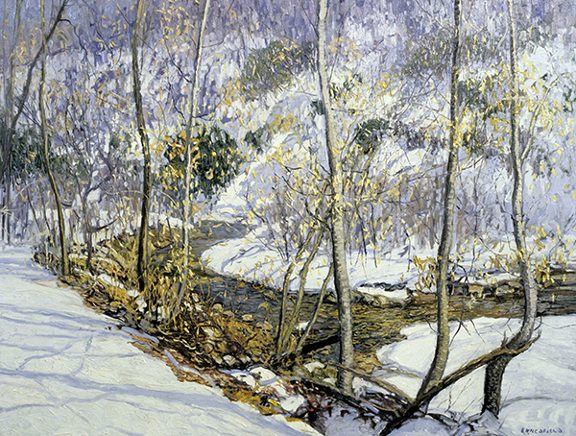Winter with Edward Willis Redfield
Showing this painting at the beginning of winter is wishful thinking in New England, as we are probably not going to see snow in any great amounts before the end of the year. But the beginning of winter is a good excuse to show an artist who was part of one of my favorite movements: American Impressionism. Edward Redfield was an amazingly prolific painter whose style fluttered between painterly realism and full-blown Impressionism. And the eighteenth of December is his birthday!
 |
| Edward Willis Redfield (1869–1965, U.S.), Laurel Run, 1916. Oil on canvas, 38" x 50" (96.5 x 127 cm). Butler Institute of American Art, Youngstown, Ohio. © 2023 Artist or Artist’s Estate. (BIAA-475) |
Although known for his many paintings of the environs of his home in New Hope, Pennsylvania, Redfield captured snow scenes—his favorite vehicle for his style—throughout the state. The subject of this work, Laurel Run, is a creek near Wilkes-Barre, Pennsylvania. Redfield emphasizes the cold air of winter by blurring the forms in the background, which is dominated by cobalt violet. This cooling color establishes a form of atmospheric perspective—showing depth by limiting detail and sharpness of forms in the middle ground and background.
Redfield’s large canvases were painted entirely outdoors (en plein air of French Impressionism). He honed his Impressionist style between 1905 and 1906, employing thick, vigorous brushstrokes in a tightly woven layering of multiple colors. For Redfield, executing snow scenes on the spot was as much an exercise in the skillful blending of nuanced blues and purples into shadows on the snow as it was of painting an entire work in one sitting outdoors.
During the last half of the 1800s, painting in America was dominated by the Society of American Artists in New York City and the National Academy of Design. These institutions ruled the art world, and their juries decided who did and did not show at annual exhibitions, just as European academies did. Like the European academies, too, the subject matter and styles sanctioned by the American institutions were history painting, grandiose classicism, and Hudson River School-influenced landscape painting, a sort of romantic realism reminiscent of the Barbizon painters in France. Such traditional styles were rejected by a younger group of artists, members of the Society who looked to France for inspiration in painting during the 1880s.
American painters who went to France were inspired by the French Impressionists, as well as expatriate Americans who were painting in Impressionism-influenced styles such as John Singer Sargent (1856–1925), James Abbott McNeill Whistler (1834–1903), and Mary Cassatt (1844–1926). Impressionism was artistically and aesthetically controversial in the 1890s. French Impressionist works had been introduced in exhibits in New York in the 1880s, and they were not well received by critics. By the time of the 1893 Chicago's Columbian Exposition, many painters were working in Impressionist styles, although painting at the time was still dominated by the Barbizon-influenced brown-yellow landscapes of the academic artists.
Born in Delaware, Redfield moved with his family to Philadelphia when he was young. His first exhibited work—a drawing of a cow—was part of a display of school children's artwork at the Philadelphia Centennial Exposition in 1876. Redfield attended art classes and studied under a commercial artist who taught him how to complete an oil and charcoal sketch in an hour, a method he would use throughout his career. The remainder of his training was academic, studying at the Philadelphia Academy of Fine Arts under academic genre and portrait painters Thomas Anschutz (1851–1912) and Thomas Hovenden (1840–1895).
Redfield also spent time with Dark Impressionist painter Robert Henri (1865–1929), the mentor of the Ash Can School. The Dark Impressionist style, characterized by a traditional academic palette with a spotlight-like contrast of light and dark, had a great impact on Redfield's pre-Impressionist works. In 1889, Redfield made his first of many trips to France, which would ultimately lead him to an appreciation of Impressionism.
The landscape studies Redfield executed during his first trip to France inspired him to become a landscape specialist, which he pursued after returning to the U.S. and settling in Center Bridge, Pennsylvania. He became a leading painter of the New Hope Art Colony, which established the Pennsylvania Impressionism school. Redfield painted until he was 75.
Correlations to Davis programs: Explorations in Art 2E Grade 1: 3.5, 4.5; Explorations in Art 2E Grade 2: 1.7, 1.9; Explorations in Art 2E Grade 5: 4.1; Explorations in Art 2E Grade 6: 2.1, 2.4; Experience Art: 4.1; A Personal Journey 2E: 5.4; The Visual Experience 4E: 8.13; Discovering Art History 4E: 13.1


Comments